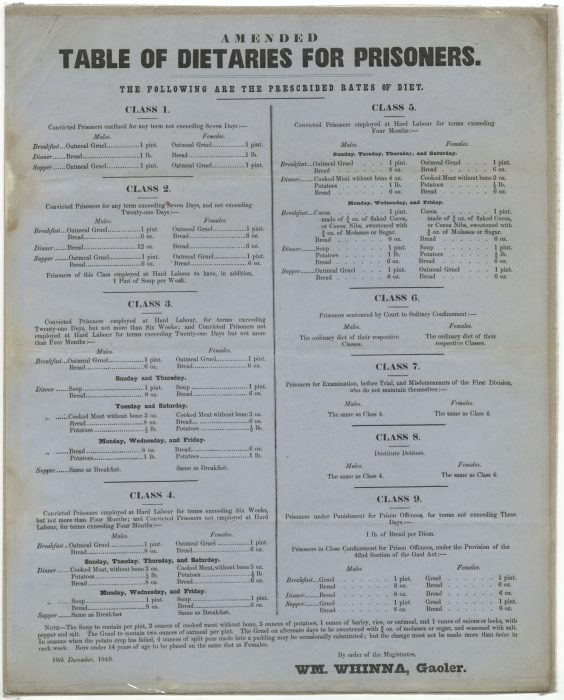Dietary for Berwick Gaol, 1849
Reference: BA/C/GA/2/6
Suggested age groups: KS2, KS3, KS4, lifelong learners
Subject areas: History, Citizenship, Maths, Biology, Food Technology
CONTEXT
The prison reform campaigners John Howard (1776, 1778, 1782) and Elizabeth Fry (1818) both visited Berwick Gaol, which was part of the Town Hall. Fry noted that the gaoler chained prisoners to the wall, because there was no other way of stopping them from escaping. There were three rooms which prisoners used during the day, but only if the gaoler was present, and seven sleeping rooms.
In 1837, a report made by the government said that Berwick had to build a new gaol. If they did not, the right to hold Quarter Sessions Court in the town would be taken away from them. Finding a site for the new prison and raising the money to pay for it was not easy for the Town Council.
The Town Council opened the new prison in November 1849, 12 years after the government ordered them to. The site for the prison was on Wallace Green. The building was designed by the Edinburgh architect Thomas Brown and cost around £8000 (over £1 million today). Some people in Berwick felt that this was too much money to spend on a prison for around 12 people.
In 1878, just 30 years after it opened, the gaol was closed. The building was sold to the Town Council for £1138 (around £135,000 today). The Town Council sold it on in 1890 for £1500.
The date on this dietary is 1849, which is the same year that the new prison in Berwick opened. A dietary is a list of food that the inmates of the gaol were given. Different types of prisoner got different types of food depending on their sentence, age and gender.
Gruel was one of the main dishes on the dietary; it is a very thin porridge made using oats and water or milk. The only vegetables that are mentioned on the dietary are onion and leek, which were used to make soup. “Molasses” is another name for black treacle.
ACTIVITIES
ACTIVITY 1
Background
A dietary is a list of food that the inmates of the gaol were given. Different types of prisoners got different types of food depending on their sentence, age and gender.
SEE
See: What different foods are the prisoners given? List each of the foods mentioned in the dietary.
See: How many meals are the prisoners given each day?
See: What are the different classes of prisoners?
See: How much more food did the male prisoners get than the female prisoners?
THINK
Think: Why are different classes of prisoners given different amounts and different types of food?
Think: What does hard labour mean?
Think: What would the prisoners’ diets have been like outside of the gaol? Would they have been better fed at home or in gaol?
Think: How many calories is it recommended for men, women and children to consume each day?
Think: Use a calorie calculator to calculate how many calories the prisoners were consuming each day.
Think: Consider the 7 major food groups. What are the main food groups present in the dietary? Make a pie chart showing the different food groups in the dietary.
DO
Do: Use the recipe from Cook It to make gruel.
Do: Use the recipe at the end of the dietary to make soup.
Do: Consider how a better diet could improve the health and well-being of prisoners. Plan a menu for a Victorian gaol which is both cost effective and gives the prisoners a healthy balanced diet.
Do: How many calories does this compare to what you eat each day? Create a food diary and calculate your daily calorie intake and a pie chart to show your daily foods broken into food groups.
Do: Research the dietary plan in present-day prisons; how does this compare to the Victorian dietary?
Resources
ACTIVITY 2
Background
The prison reform campaigners John Howard (1776, 1778, 1782) and Elizabeth Fry (1818) both visited Berwick Gaol, which was part of the Town Hall. In 1837, a report made by the government said that Berwick had to build a new gaol.
SEE
See: What did Elizabeth Fry note that the gaoler did to stop the prisoners escaping from Berwick Gaol?
See: What year did the government report that a new gaol had to be built in Berwick?
See: What did the government say would happen if a new gaol was not built?
See: What date was the new Berwick Gaol opened?
See: How much did it cost to build the new gaol?
THINK
Think: Why was there a need for prison reform?
Think: Who were the main prison reformers?
Think: What were John Howard’s main observations in his report on prison conditions?
Think: What changes did John Howard suggest should be made to prisons?
DO
Do: Choose one of John Howard’s recommendations for prison reform. Create a presentation about what observations led to this recommendation being made, what the recommendation included, and how effective it was.
Do: Consider the conditions of prisons in the present day. How do they compare to Victorian prisons? Discuss if there is still a need for prison reform today.
Resources
OTHER ONLINE RESOURCES
Spartacus Educational website, page about Elizabeth Fry:
https://spartacus-educational.com/REfry.htm
Spartacus Educational website, page about John Howard:
https://spartacus-educational.com/REhoward.htm
Howard League website, page with biography of John Howard:
https://howardleague.org/john-howard/
The State of Prisons in England by John Howard, Google Books:
https://books.google.co.uk/books?id=zTR9istX3x4C&source=gbs_navlinks_s
Our Criminal Ancestors website (from University of Hull), page about Quarter Sessions: https://ourcriminalancestors.org/quarter-sessions/
Historic England website, page for Berwick Gaol:
https://historicengland.org.uk/listing/the-list/list-entry/1446315
BBC Bitesize website, page about prison reform:
https://www.bbc.co.uk/bitesize/guides/z938v9q/revision/5


